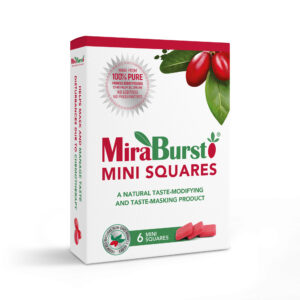
Miracles Berries and the Science of Taste

When it comes to the miracle berry, the true miracle is not the taste of the berry itself but how it works on the taste receptors on the tongue. So how do these taste receptors normally work and how does the miracle berry temporarily hijack the normal functioning of the bitter and sour receptors to make them experience a sweet taste after the miracle berry is ingested?
Why Do We Taste?
In many ways, our sense of taste is linked to evolution. This sense aided us in survival. In many instances, the bitter or sour taste indicated a poisonous plant. On the other hand, a sweet or salty taste could indicate a food high in nutrients. Savory foods often signal a protein rich food. Sweet, sour, bitter, salty, and savory are all conveyed by means of neuroepithelial cells, or sensory cells.
What We Were Taught was Wrong
For many years, there was a misconception that differing tastes had different locations on the tongue. Science now knows that this is untrue. All areas of the tongue have the ability to sense all the tastes. What is true is that the sides of the tongue are more sensitive than the middle and that the back of the tongue is more sensitive to bitter tastes. It’s thought that this is what helped protect us from ingesting poisonous or harmful foods before they were swallowed.
Not Just Your Taste Buds
What we experience as taste is a combination of different sensations. It is not limited to the tongue and the taste buds but also the smell, the temperature, and the texture of what we eat. With that combination, we get to total of our sense of taste. When our sense of smell is inhibited, so is our sense of taste. Both are connected to our involuntary nervous system. This is why smell can also make us feel sick or nauseous.
What Makes Something Sour or Bitter?
The information that is sent to the brain via the tongue is what gives food its nuances of sweet or bitter. Many foods are a combination of those flavors. In the case of sour foods, the sensation of “sour” is caused by hydrogen ions that get split off by an acid. Foods that are bitter taste that way because of a variety of substances. There are nearly 35 different proteins in the cells that respond to the taste of bitter.
[mira-cta]
How Does Miraculin Change the Way We Perceive Sour and Bitter?
The miracle berry contains a glycoprotein called miraculin that acts as a taste-modifying agent. This protein binds to the receptors on the tongue that detect the taste of sweet. Although we don’t know for certain what the exact mechanism of miraculin is, it appears that it causes acids to activate the sweet receptors on the tongue, making any bitter or sour foods perceived as sweet.
Now you can purchase freshly frozen miracle berries and easy melt miracle fruit tablets from MiraBurst. Experience the flavor enhancing properties of the miracle berry for yourself.

